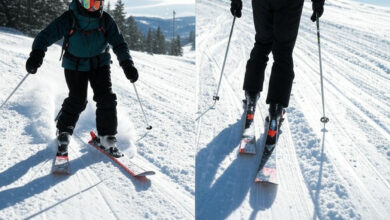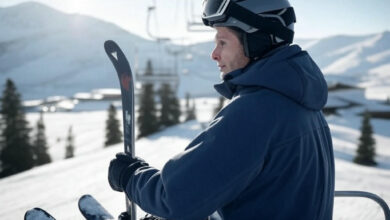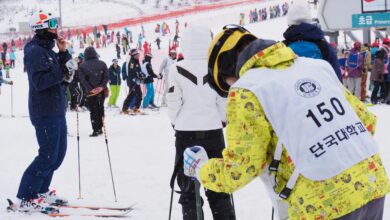How To Use Ski Lifts (Beginners Guide)
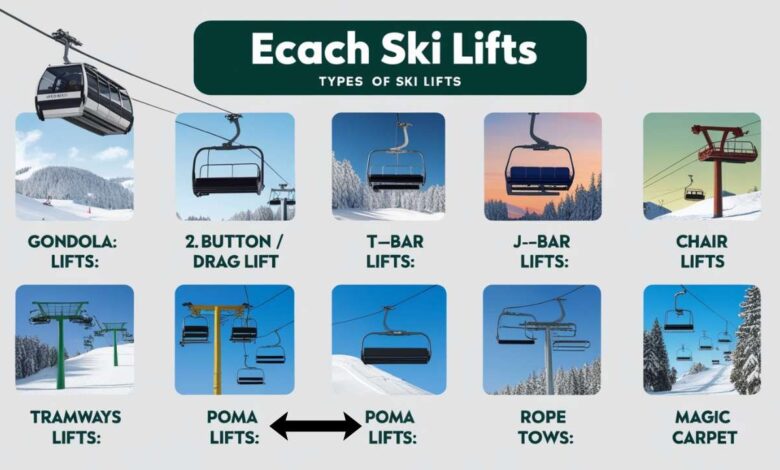
Learning how to use ski lifts is a crucial skill for any beginner hitting the slopes. Ski lifts are your gateway to the mountain’s best runs, but they can be a bit intimidating if you’ve never used one before. This beginners guide will walk you through the basics, from boarding the lift to safely getting off at the top, ensuring you feel confident and ready to enjoy your skiing experience.
For new skiers, knowledge of the procedure of the use of a ski lift could make all the difference in having an easy and exciting day on the mountain. This manual will cover everything you need to recognize, inclusive of guidelines on staying balanced, what to expect at every stage, and common errors to keep away from. By the end of this newsletter, you’ll be geared up with the knowledge to apply ski lifts without problems, so you can recognize what simply matters—having amusing on the slopes!
Contents
There are 9 main types of ski lifts that you will be likely to discuss here:
1. Gondola Lifts:
2. Button / Drag Lift
3. T-bar Lifts
4. J-Bar Lifts
5. Chair Lift
6. Poma Lifts:
7. Tramways Lifts
8. Rope Tows:
9. Magic Carpet
Ski lifts are essential for getting skiers up the mountain, and understanding how they work is key to making the most of your time on the slopes. Whether you’re a beginner or an experienced skier, knowing the different types of ski lifts can help you navigate the mountain with confidence. Each type of lift has its own unique features and is designed for specific terrain and skier levels. This beginners guide will walk you through the nine main types of ski lifts you’re likely to encounter, explaining how they work and offering tips on how to use them safely and efficiently.
Familiarizing yourself with these ski lifts will make your skiing experience smoother and more enjoyable. From the enclosed comfort of gondola lifts to the simplicity of rope tows, each lift type offers a different way to access the slopes. Let’s dive into the details of each lift and learn how they can help you make the most of your skiing adventure.

1. What is a Gondola Ski Lift?
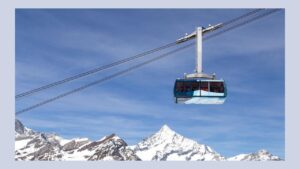
Gondola lifts are among the most popular and comfortable ski lifts you’ll encounter. These lifts consist of enclosed cabins suspended from a cable, which carry skiers up the mountain. Gondolas are perfect for all weather conditions, providing protection from the elements and offering stunning panoramic views as you ascend. They are easy to use for beginners since you can walk into the cabin at the base station and simply sit down for the ride.
To use a gondola raise, anticipate your cabin to reach, and step inner when the doors open. The lift will slow down at the station, making it smooth to board. Once inside, sit down and experience the smooth, scenic journey to the top of the mountain. When you attain your destination, the gondola will gradually down again, permitting you to go out appropriately. Gondola lifts are best for skiers of all levels, specifically beginners, as they provide a gentle creation for using ski lifts.
Gondolas often perform on longer routes, making them a great preference in case you need to attain higher altitudes or get admission to distant slopes. They normally convey more than one passenger, so they are also a social way to rise up the mountain, presenting a hazard to chat with fellow skiers at some stage in the trip.
2. What is a Button / Drag Ski Lift?
Button lifts, also known as drag lifts, are a common sight at many ski resorts, especially on beginner slopes. These lifts consist of a series of button-like discs attached to a cable, which skiers place between their legs to be gently pulled uphill. Button lifts are a bit more challenging than gondolas because they require balance and coordination to use effectively.
Using a Button Lift
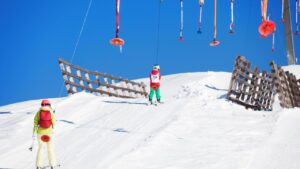
To use a button lift, role yourself at the place to begin and grasp the deal with as it tactics. Place the button between your legs, keep on tight, and let the carry pull you up the slope. It’s vital to hold your skis parallel and your body comfortable to avoid losing your balance. The raise will drag you uphill, and whilst you reach the top, absolutely let cross the deal with and ski far from the elevated tune.
Button lifts are perfect for short distances and mild slopes. They are regularly used on newbie runs due to the fact they allow skiers to exercise their skills with no need to use extra complicated lifts. With a bit of exercise, you will discover button lifts are smooth and convenient to apply.
3. What is a T-bar Lift?
T-bar lifts are similar to button lifts but are designed to carry two skiers at a time. The T-bar is a metal bar shaped like a “T” that you and a partner place behind your legs or buttocks. Like button lifts, T-bar lifts require balance and coordination but can be a bit easier because you have someone to share the ride with.
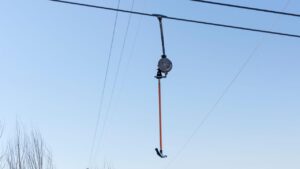
To use a T-bar elevate, line up with your partner at the place to begin and look ahead to the T-bar to approach. As it reaches you, take hold of the bar and place it in the back of your legs, allowing the lift to drag you both uphill. It’s critical to stay in sync along with your partner and hold your skis parallel to avoid tipping over. The ride can be a piece bumpy, so staying comfortable and focused is key.
When you reach the top, release the T-bar by means of letting it lift off in the back of you and ski away from the carry tune. T-bar lifts are often found on intermediate slopes and provide an amazing manner to exercise your stability and teamwork at the same time as learning the terrain.
4. What is J-Bar Lift?
J-bar lifts are a variation of the T-bar lift, designed for solo skiers. Instead of a “T” shape, the bar is shaped like a “J,” and it hooks behind one leg or your buttocks to pull you uphill. J-bar lifts are less common than T-bars but are still used in some ski resorts, particularly on smaller or less crowded slopes.
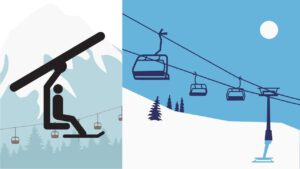
To use a J-bar lift, position yourself at the start line and await the bar to technique. As it arrives, seize the take care of and hook it behind your leg or sit down on it because it pulls you uphill. The key to the usage of a J-bar carry is to stay relaxed and keep your skis instantly to maintain stability.
When you attain the top, launch the bar by letting it swing far from you and ski off the lift track. J-bar lifts offer solo enjoyment and are a great option for skiers who need to exercise their approach without counting on an associate.
5. What is a Chairlift?
Chair lifts are one of the most common and versatile ski lifts found in resorts worldwide. These lifts consist of a series of chairs attached to a moving cable, which carry skiers up the mountain. Chair lifts can accommodate one to six skiers per chair, depending on the design, and are used on a wide range of slopes, from beginner to advanced.
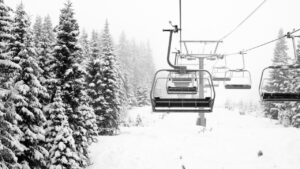
How to use a Chairlift:
To use a chair raise, line up at the loading location and wait for the chair to technique. As the chair arrives, take a seat down quickly and decrease the safety bar in front of you. The lift will bring you up the mountain, offering a cushy and scenic trip. Keep your skis pointed forward and live seated till you attain the top.
When you method the unloading station, increase the protection bar, stand up because the chair slows down, and go with the flow of the elevator onto the slope. Chair lifts are easy to apply and are ideal for skiers of all tiers, making them a staple at any ski motel.
Follow these chair lift tips to stay out of trouble:
- If you’re by yourself, sit down in the center.
- If you’re with different people, evenly sit across the complete period of the bench.
- When you pull the bar down make certain your head is out of the way (If you’re tall like me, the bar can come down and hit you on the pinnacle, so pull it lightly down and lean lower back or duck down.
- When you region your skis onto the bar to rest, be cautious not to collide together with your other skis as they are able to once in a while off (Bindings for beginner skiers are often unfastened and the boot and ski can come off when strain is carried out.)
- If something falls off the raise, wait till you get to the top of the elevate and inform the carry operator. He can both radio down for it to be brought up by using someone on the lift or you may ask an extra superior skier to accumulate your fallen item. (don’t try to go off-piste if you are a new skier, it’s rocky, icy, and will be dangerous for you).
6. What is Poma Lift?
Poma lifts, also known as platter lifts, are another type of drag lift similar to button lifts. Instead of a button, Poma lifts have a small round disc that skiers place between their legs to be pulled uphill. These lifts are common on beginner slopes and are designed for solo use.
To use a Poma elevate, stand at the loading point and grasp the disc to cope with its techniques. Place the disc among your legs and let the lift pull you uphill. It’s critical to stay balanced and maintain your skis parallel to avoid slipping out of the track. The elevator will take you to the top of the slope, wherein you can release the disc and ski away.
Poma lifts are easy to use with a chunk of exercise and are an extremely good way for novices to get snug with using ski lifts.
7. What is Tramways Lift?
Tramways, also known as aerial trams or cable cars, are large cabins that carry skiers and snowboarders up the mountain on a fixed cable. These lifts are capable of transporting a large number of passengers at once, making them ideal for reaching high altitudes and accessing remote slopes. Tramways are often used in larger ski resorts and are known for their stability and scenic views.
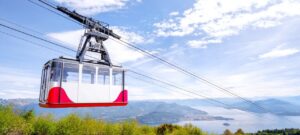
To use a tramway lift, board the cabin at the base station in conjunction with other passengers. The tramway operates on a timetable, so once the cabin is full, the doors will be near, and the tram will ascend the mountain. During the experience, you could stand or sit, and experience the panoramic perspectives as you pass better up the slopes.
Tramways provide a completely unique experience as they often cover long distances and offer to get admission to challenging and exciting terrain. They are appropriate for all tiers of skiers and are a famous desire for those trying to explore one-of-a-kind components of the mountain.
8. What is Rope Tows?
Rope tows are one of the simplest and oldest types of ski lifts. They consist of a continuously moving rope that skiers hold onto to be pulled uphill. Rope tows are typically used on very gentle slopes and are a great way for beginners to practice using lifts without the complexity of more advanced systems.
To use a rope tow, method the rope and grasp it with each hand. Hold on firmly because the rope pulls you uphill, keeping your skis pointed instantly and your frame slightly leaned ahead for balance. Rope tows require a little electricity and coordination, but they may be a brilliant way to construct self-assurance at the slopes. The New Ski is a great hub all about skiing.
When you reach the pinnacle, really allow go of the rope and ski off to the side. Rope tows are easy to use and are often located on newbie slopes or small ski regions.
9. What is Magic Carpet?
Magic carpets are conveyor belt-style lifts that are easy and accessible for beginners, especially young children and first-time skiers. These lifts are flat, moving belts that you stand on while wearing your skis or snowboard, and they slowly carry you up the hill. Magic carpets are usually found on very gentle slopes, such as bunny hills, and are the easiest type of lift to use.
How to use a magic carpet:
To use a magic carpet, surely step onto the moving belt and stand still because it leads you up the slope. Keep your skis or snowboard pointed forward and your balance consistent. When you attain the top, step off the belt and flow away onto the slope.
Magic carpets are best for novices as they offer a mild creation to ski lifts without requiring any unique abilities or coordination. They are perfect for gaining knowledge of a way to balance on skis and getting snug with transferring uphill.
FAQ
1. What should I do if I fall off a ski lift?
If you fall off a ski lift while boarding or riding, don’t panic. Move away from the lift path as quickly as possible to avoid getting in the way of other skiers. If you fall while getting off, stay calm and slide or roll out of the way. Lift operators are trained to stop the lift in these situations, so you’ll have time to get back on your feet.
2. Can beginners use all types of ski lifts?
Beginners can use most ski lifts, but some lifts, like T-bars or button lifts, might be a bit challenging at first. Start with easier lifts like magic carpets or gondolas, and as you gain confidence, you can try other types of lifts.
3. How do I know when to get off the lift?
Most ski lifts have clear signs and markers indicating when to get off. Pay attention to the signs and listen for announcements. The lift will usually slow down near the top, giving you time to prepare to stand up and glide off smoothly.
4. What should I do if I miss getting off the lift?
If you miss your stop and the lift continues past the unloading area, don’t worry. Stay seated and alert the lift operator if possible. The lift might bring you back down, or you can wait until the next unloading station.
Conclusion:
Understanding how to use ski lifts is an essential part of becoming a confident skier. By familiarizing yourself with the different types of lifts and following this beginners guide, you can navigate the slopes with ease and enjoy your time on the mountain. Whether you’re stepping onto a magic carpet for the first time or riding a chair lift to higher altitudes, each lift offers a unique way to explore and enjoy the skiing experience. With practice and patience, you’ll soon be using ski lifts like a pro, ready to take on new challenges and make the most of your skiing adventures.


